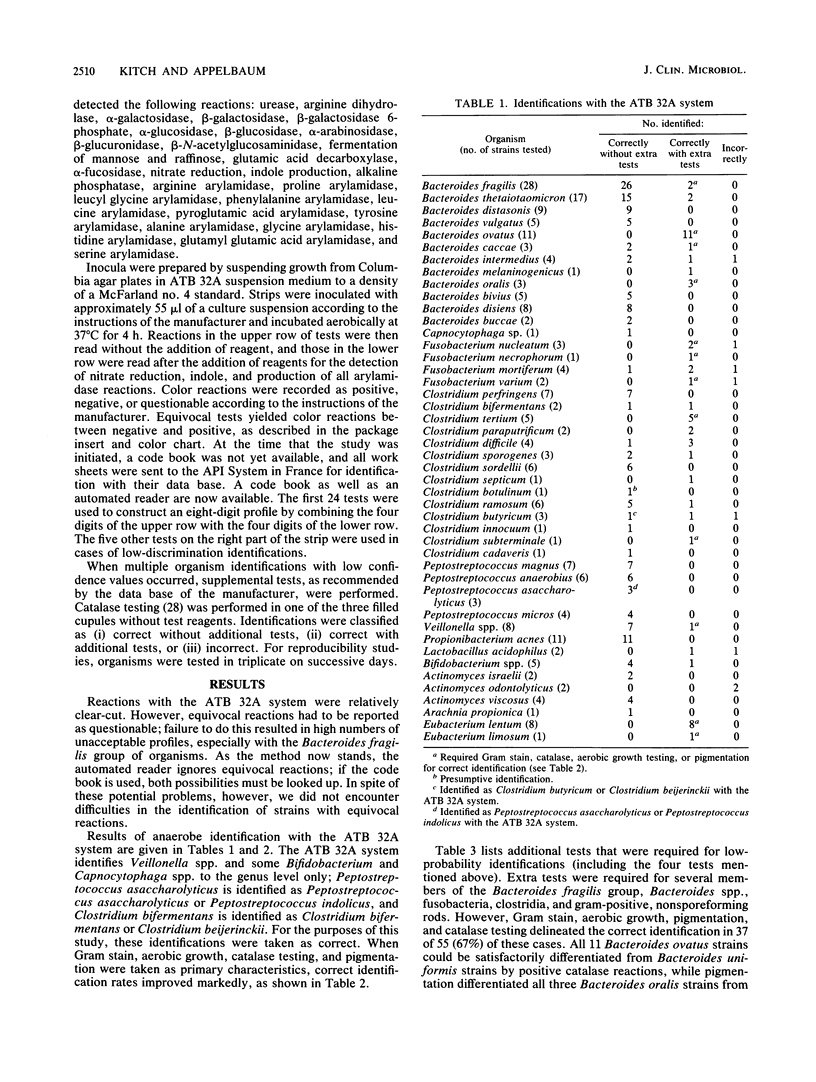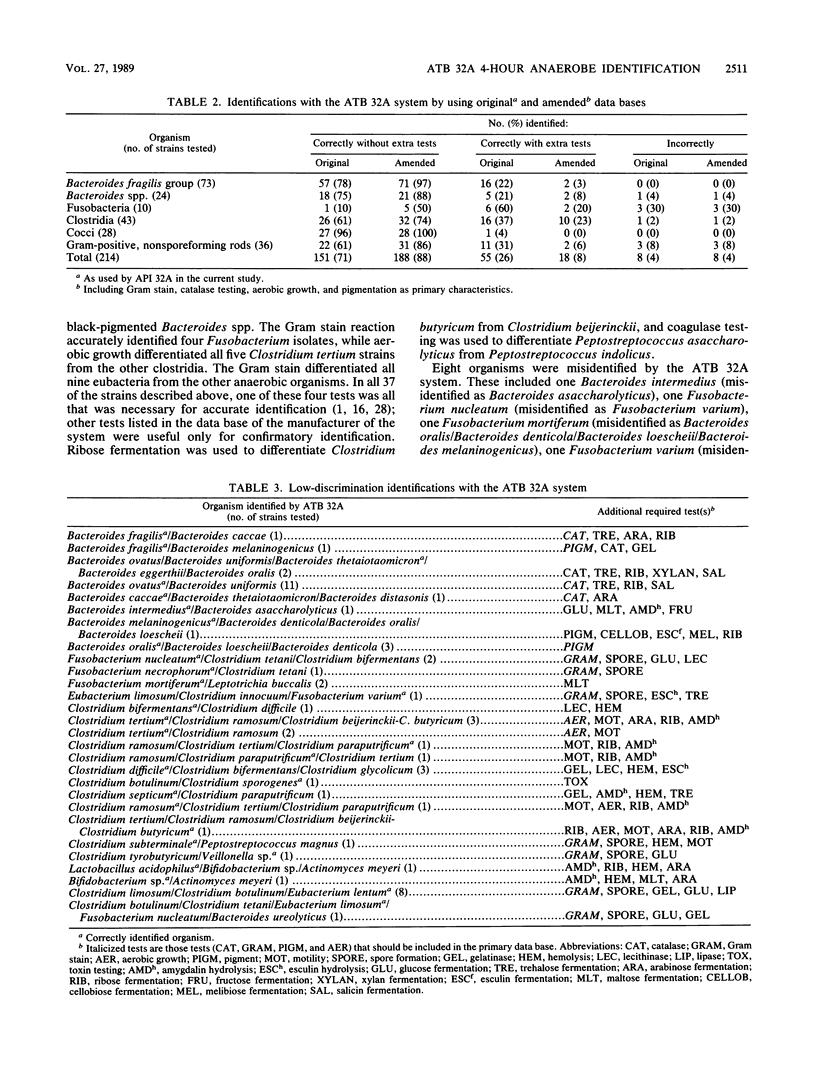Abstract
The ATB 32A system (API System SA, La Balme les Grottes, Montalieu-Vercieu, France) was evaluated for use in the identification of 214 anaerobes. Organisms included 73 isolates of the Bacteroides fragilis group, 24 Bacteroides spp., 10 fusobacteria, 43 clostridia, 28 cocci, and 36 gram-positive, nonsporeforming rods. With the concomitant use of Gram stain, pigmentation, catalase testing, and aerobic growth, the ATB 32A system correctly identified 97% of the B. fragilis group isolates, 88% of Bacteroides spp., 50% of fusobacteria, 74% of clostridia, 100% of cocci, and 86% of the gram-positive, nonsporeforming rods. Overall, 188 strains (88%) were correctly identified, with 18 (8%) requiring extra tests, other than the four mentioned above, for correct identification. Eight strains were misidentified, including one Bacteroides sp., three fusobacteria, one Clostridium sp., and three gram-positive, nonsporeforming rods. Reproducibility was very good, with 12 of 14 strains (86%) tested in triplicate yielding identical correct results on each of three occasions and 2 strains (14%) yielding identical correct results on two occasions. There was a low-probability identification (including the correct species) on the third testing. The ATB 32A system represents a worthwhile advance in systems used for the identification of clinically significant anaerobic bacteria.
Full text
PDF




Selected References
These references are in PubMed. This may not be the complete list of references from this article.
- Appelbaum P. C., Kaufmann C. S., Depenbusch J. W. Accuracy and reproducibility of a four-hour method for anaerobe identification. J Clin Microbiol. 1985 Jun;21(6):894–898. doi: 10.1128/jcm.21.6.894-898.1985. [DOI] [PMC free article] [PubMed] [Google Scholar]
- Appelbaum P. C., Kaufmann C. S., Keifer J. C., Venbrux H. J. Comparison of three methods for anaerobe identification. J Clin Microbiol. 1983 Sep;18(3):614–621. doi: 10.1128/jcm.18.3.614-621.1983. [DOI] [PMC free article] [PubMed] [Google Scholar]
- Bate G. Comparison of Minitek Anaerobe II, API An-Ident, and RapID ANA systems for identification of Clostridium difficile. Am J Clin Pathol. 1986 Jun;85(6):716–718. doi: 10.1093/ajcp/85.6.716. [DOI] [PubMed] [Google Scholar]
- Bergan T., Vangdal M., Salveson A. Evaluation of Minitec and API as rapid diagnostic methods for anaerobic bacteria. Scand J Gastroenterol Suppl. 1984;91:103–111. [PubMed] [Google Scholar]
- Buesching W. J., Svirbely J. R., Ayers L. W. Evaluation of the Anaerobe-Tek system for identification of anaerobic bacteria. J Clin Microbiol. 1983 May;17(5):824–829. doi: 10.1128/jcm.17.5.824-829.1983. [DOI] [PMC free article] [PubMed] [Google Scholar]
- Burlage R. S., Ellner P. D. Comparison of the PRAS II, AN-Ident, and RapID-ANA systems for identification of anaerobic bacteria. J Clin Microbiol. 1985 Jul;22(1):32–35. doi: 10.1128/jcm.22.1.32-35.1985. [DOI] [PMC free article] [PubMed] [Google Scholar]
- Dellinger C. A., Moore L. V. Use of the RapID-ANA System to screen for enzyme activities that differ among species of bile-inhibited Bacteroides. J Clin Microbiol. 1986 Feb;23(2):289–293. doi: 10.1128/jcm.23.2.289-293.1986. [DOI] [PMC free article] [PubMed] [Google Scholar]
- Gresser M. E., Shanholtzer C. J., Gerding D. N., Garrett C. R., Peterson L. R. Evaluation of the 24-h API 20A anaerobe system for identification of Clostridium difficile. J Clin Microbiol. 1984 Jun;19(6):915–916. doi: 10.1128/jcm.19.6.915-916.1984. [DOI] [PMC free article] [PubMed] [Google Scholar]
- Gulletta E., Amato G., Nani E., Covelli I. Comparison of two systems for identification of anaerobic bacteria. Eur J Clin Microbiol. 1985 Jun;4(3):282–285. doi: 10.1007/BF02013653. [DOI] [PubMed] [Google Scholar]
- Hansen S. L., Stewart B. J. Comparison of API and Minitek to Center for Disease Control methods for the biochemical characterization of anaerobes. J Clin Microbiol. 1976 Sep;4(3):227–231. doi: 10.1128/jcm.4.3.227-231.1976. [DOI] [PMC free article] [PubMed] [Google Scholar]
- Hanson C. W., Cassorla R., Martin W. J. API and Minitek systems in identification of clinical isolates of anaerobic gram-negative bacilli and Clostridium species. J Clin Microbiol. 1979 Jul;10(1):14–18. doi: 10.1128/jcm.10.1.14-18.1979. [DOI] [PMC free article] [PubMed] [Google Scholar]
- Head C. B., Ratnam S. Comparison of API ZYM system with API AN-Ident, API 20A, Minitek Anaerobe II, and RapID-ANA systems for identification of Clostridium difficile. J Clin Microbiol. 1988 Jan;26(1):144–146. doi: 10.1128/jcm.26.1.144-146.1988. [DOI] [PMC free article] [PubMed] [Google Scholar]
- Hofstad T. Evaluation of the API ZYM system for identification of Bacteroides and Fusobacterium species. Med Microbiol Immunol. 1980;168(3):173–177. doi: 10.1007/BF02122851. [DOI] [PubMed] [Google Scholar]
- Hussain Z., Lannigan R., Schieven B. C., Stoakes L., Kelly T., Groves D. Comparison of RapID-ANA and Minitek with a conventional method for biochemical identification of anaerobes. Diagn Microbiol Infect Dis. 1987 May;7(1):69–72. doi: 10.1016/0732-8893(87)90073-3. [DOI] [PubMed] [Google Scholar]
- Karachewski N. O., Busch E. L., Wells C. L. Comparison of PRAS II, RapID ANA, and API 20A systems for identification of anaerobic bacteria. J Clin Microbiol. 1985 Jan;21(1):122–126. doi: 10.1128/jcm.21.1.122-126.1985. [DOI] [PMC free article] [PubMed] [Google Scholar]
- Lombard G. L., Whaley D. N., Dowell V. R., Jr Comparison of media in the Anaerobe-Tek and Presumpto plate systems and evaluation of the Anaerobe-Tek system for identification of commonly encountered anaerobes. J Clin Microbiol. 1982 Dec;16(6):1066–1072. doi: 10.1128/jcm.16.6.1066-1072.1982. [DOI] [PMC free article] [PubMed] [Google Scholar]
- Marler L., Allen S., Siders J. Rapid enzymatic characterization of clinically encountered anaerobic bacteria with the API ZYM system. Eur J Clin Microbiol. 1984 Aug;3(4):294–300. doi: 10.1007/BF01977476. [DOI] [PubMed] [Google Scholar]
- Moore H. B., Sutter V. L., Finegold S. M. Comparison of three procedures for biochemical testing of anaerobic bacteria. J Clin Microbiol. 1975 Jan;1(1):15–24. doi: 10.1128/jcm.1.1.15-24.1975. [DOI] [PMC free article] [PubMed] [Google Scholar]
- Murray P. R., Weber C. J., Niles A. C. Comparative evaluation of three identification systems for anaerobes. J Clin Microbiol. 1985 Jul;22(1):52–55. doi: 10.1128/jcm.22.1.52-55.1985. [DOI] [PMC free article] [PubMed] [Google Scholar]
- Rosenblatt J. E. Anaerobic identification systems. Clin Lab Med. 1985 Mar;5(1):59–65. [PubMed] [Google Scholar]
- Savuto P. S., Ellner P. D. Evaluation of a microtiter system for identification of anaerobic bacteria. J Clin Microbiol. 1984 Jul;20(1):81–83. doi: 10.1128/jcm.20.1.81-83.1984. [DOI] [PMC free article] [PubMed] [Google Scholar]
- Schreckenberger P. C., Celig D. M., Janda W. M. Clinical evaluation of the Vitek ANI card for identification of anaerobic bacteria. J Clin Microbiol. 1988 Feb;26(2):225–230. doi: 10.1128/jcm.26.2.225-230.1988. [DOI] [PMC free article] [PubMed] [Google Scholar]
- Stargel D., Thompson F. S., Phillips S. E., Lombard G. L., Dowell V. R., Jr Modification of the Minitek Miniaturized Differentiation System for characterization of anaerobic bacteria. J Clin Microbiol. 1976 Mar;3(3):291–301. doi: 10.1128/jcm.3.3.291-301.1976. [DOI] [PMC free article] [PubMed] [Google Scholar]
- Summanen P., Jousimies-Somer H. Comparative evaluation of RapID ANA and API 20 A for identification of anaerobic bacteria. Eur J Clin Microbiol Infect Dis. 1988 Dec;7(6):771–775. doi: 10.1007/BF01975045. [DOI] [PubMed] [Google Scholar]
- Tanner A. C., Strzempko M. N., Belsky C. A., McKinley G. A. API ZYM and API An-Ident reactions of fastidious oral gram-negative species. J Clin Microbiol. 1985 Sep;22(3):333–335. doi: 10.1128/jcm.22.3.333-335.1985. [DOI] [PMC free article] [PubMed] [Google Scholar]
- van Winkelhoff A. J., Clement M., de Graaff J. Rapid characterization of oral and nonoral pigmented Bacteroides species with the ATB Anaerobes ID system. J Clin Microbiol. 1988 May;26(5):1063–1065. doi: 10.1128/jcm.26.5.1063-1065.1988. [DOI] [PMC free article] [PubMed] [Google Scholar]


